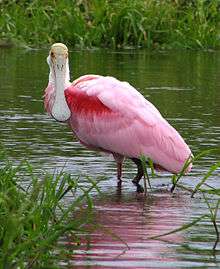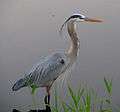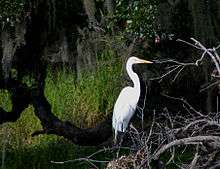Myakka River State Park
Myakka River State Park is a Florida State Park, that is located nine miles (14 km) east of Interstate 75 in Sarasota County and a portion of southeastern Manatee County on the Atlantic coastal plain. This state park consists of 37,000 acres (150 km2), making it one of the state's largest parks. It is also one of the oldest parks in the state. It was delineated in the 1930s by the Civilian Conservation Corps. A small portion (1,920 acres or 7.8 km2) of the park was the gift of the family of Bertha Palmer to the state. The park is named after the Myakka River.
| Myakka River State Park | |
|---|---|
IUCN category V (protected landscape/seascape) | |
 | |
| Location | Manatee and Sarasota counties, Florida, USA |
| Nearest city | Sarasota, Florida |
| Coordinates | 27°14′22″N 82°19′00″W |
| Area | 37,000 acres (150 km2) |
| Established | February 18, 1941[1] |
| Governing body | Florida Department of Environmental Protection |

Environment
Myakka River State Park is in the southeastern conifer forests ecoregion. Plant communities in areas of the park with drier soils are a mixture of pine forests, scrub, and prairies. Florida longleaf pine sandhills are woodlands dominated by longleaf pine (Pinus palustris). South Florida pine flatwoods are open woodlands of (Pinus elliottii var. densa) with a dense ground cover of grasses and shrubs. Florida peninsula inland scrub consists of sand pines (Pinus clausa) growing amid shrublands of evergreen oaks. Florida dry prairies are flat, nearly treeless plains with dense cover of grasses and saw palmetto (Serenoa repens).[2]
Wetlands in the park include marshes and cypress domes. Floridian highlands freshwater marshes are prairies composed of different herbaceous plant communities that vary based on water depth. Southern coastal plain nonriverine cypress domes are small wetlands of pond cypress (Taxodium ascendens) notable for their dome-shaped appearance.[2]
A karst sinkhole named Deep Hole is located on the northwest bank of the Myakka River in the Wilderness Preserve. The sink is 41 meters deep though no evidence of a spring was found by a 2011-2012 research team.[3]
Rivers in the park support hammocks and floodplain forests. Near the floodplains of spring-fed rivers grow southern coastal plain hydric hammocks, dense forests of evergreen and deciduous hardwood trees. Blackwater rivers support southern coastal plain blackwater river floodplain forests of baldcypress (Taxodium distichum) along their banks.[2]
Things to do

The park is noted for its wildlife and some of the rare birds seen only in Florida, such as the roseate spoonbill, frequent the park. Native flora flourishes in the park. There are many species of fish, amphibians, reptiles, and mammals to learn about and enjoy watching as well.
Myakka River State Park has an excellent system of hiking trails. Walking trails crisscross the eastern side of the park.
Six primitive campgrounds are accessible by trail throughout the park: Mossy Hammock, Bee Island, Panther Point, Honore, Oak Grove and Prairie.
Horseback riding and biking is permitted on certain designated trails and roads in the park. This part of the park is dominated by expanses of very low vegetation, fields of palmetto, that make a transition to islands, or hammocks, of tall pine and oak trees.
A good portion of the park is accessible by automobile. Myakka River State Park's main road, a 6.5-mile drive between the North and South ends, leads visitors to a boardwalk out to the river and a lake that is excellent for bird watching.
The main drive is also popular with cyclists, runners, and skaters. Bicycle traffic can be heavy, especially on weekends and holidays.
A short walk from the main road reveals Myakka's Canopy walkway, a novel suspension bridge and tower providing researchers and visitors with views of the forest canopy and a spectacular above-the-treetops view of the entire park.
Picnic areas, canoeing, boat tours, and developed campsites are available. The park even has five cabins that were built not with logs, but with the trunks of native sabal palms.
References
- Smith, Mark D. "Myakka River State Park". Sarasota History Alive. Sarasota County History Center. Retrieved April 11, 2018.
- "Land Cover Viewer - Map". National Gap Analysis Program. United States Geological Survey. Retrieved February 15, 2013.
- Culter, JK; Bowen, C; Ryan, J; Perry, J; Janneman, R; Lin, W (2013). "Exploration of Deep hole, Myakka river state park, Florida". In: Lang, M.A., and M.D.J. Sayer, editors. 2013. Proceedings of the 2013 AAUS/ESDP Curaçao Joint International Scientific Diving Symposium, October 24–27, 2013, Curaçao. Dauphin Island, AL. American Academy of Underwater Sciences. Retrieved July 6, 2014.
Gallery




 The Boat Basin with airboats Gator Gal and Myakka Maiden
The Boat Basin with airboats Gator Gal and Myakka Maiden Alligators abound
Alligators abound Kayaking on the Myakka River
Kayaking on the Myakka River Myakka River Sunset
Myakka River Sunset- View walking on the Canopy Walkway
 Trails flooded after heavy rains
Trails flooded after heavy rains
External links
| Wikimedia Commons has media related to Myakka River State Park. |